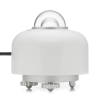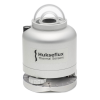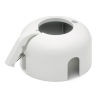Strahlungssensoren / SR30-L

Überblick
Der SR30 (ISO 9060:2018 Klasse A, spectrally flat) wird von Hukseflux hergestellt und enthält die "Recirculating Ventilation and Heating (RVH™)" Technik. Der SR30 erfüllt den IEC 61724-1 Standard ohne weiteres Zubehör während andere Pyranometer eine zusätzliche Lüftung/Heizung brauchen. Der Sensor ist besonders für solare Resourcenmessung und Performance Monitoring von Solaranlagen geeignet.
Funktionen und Vorteile
- Heated for high data availability, featuring RVH™ technology
- Compliant with IEC 61724-1:2017 Class A
- Remote sensor diagnostics
Bilder








Zugehörige Produkte
Spezifikationen
| Sensor | High-quality blackened thermopile protected by two glass domes with integrated heater and ventilation |
| Measurement Description | Monitors solar radiation for the full solar spectrum range |
Hemispherical Solar Radiation |
|
| Heater | RVH™ (Recirculating Ventilation and Heating) |
| ISO Classification | Spectrally flat Class A (secondary standard) ISO 9060:2018 |
| IEC 61724-1:2017 Compliance | Class A |
| Calibration Uncertainty | < 1.2% (k = 2) |
| Heating | Included |
| Ventilation | Included |
| Technology Employed | Recirculating Ventilation and Heating (RVH™) |
| Standard Operating Mode | Heated and ventilated |
| Power Consumption @ 12 Vdc | < 2.3 W |
| Zero Offset A | < 2 W/m2 |
| Calibration Traceability | To WRR |
| Calibration Registers | Accessible to users |
| Spectral Range | 285 to 3000 x 10-9 m |
| Sensitivity | Digital output |
| Operating Temperature Range | -40 to +80°C (rated) |
| Temperature Response | < ±0.4% (-30 to +50°C) |
| Temperature Response Test of Individual Instrument | Report included |
| Directional Response Test of Individual Instrument | Report included |
| Rated Operating Voltage Range | 5 to 30 Vdc |
Sensor Tilt Angle |
|
| Tilt Measurement Uncertainty | ±1° (0 to 90°) |
| Tilt Sensor Test of Individual Instrument | Report included |
Operation in Low-Power Mode |
|
| Operating Condition | Heater and ventilator [OFF] |
| Zero Offset A | 5 W/m2 (unventilated) |
| Power Consumption @ 12 Vdc | < 0.1 W |
Digital Output |
|
| Output |
|
| Communication Protocol | Modbus over two-wire RS-485 |
| Transmission Mode | RTU |
Dokumente
Broschüren Produkte
Übereinstimmung mit Richtlinien u. Vorschriften
Downloads
SR30 Example Program v.1 (2 KB) 10-12-2020
The example CR1000X program measures the SR30 sensor. The program will store the values if the result code is zero, which indicates a properly working sensor. If the result code is not zero, NANs will be stored for the measurements.
Aufgelistet unter
Common Accessory for the following products:

